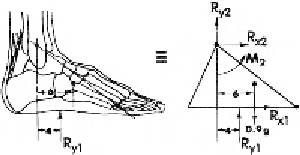Biomedical Engineering Reference
In-Depth Information
Equations
1.
F
x
=
ma
x
R
xp
−
R
xd
=
ma
x
(5.1)
2.
F
y
=
ma
y
R
yp
−
R
yd
−
mg
=
ma
y
(5.2)
3. About the segment COM,
M
=
I
0
α
(5.3)
Note that the muscle moment at the proximal end cannot be calculated until
the proximal reaction forces
R
xp
and
R
yp
have first been calculated.
Example 5.1 (see Figure 5.6).
In a static situation, a person is standing on
one foot on a force plate. The ground reaction force is found to act 4 cm
anterior to the ankle joint. Note that convention has the ground reaction force
R
y
1
always acting upward. We also show the horizontal reaction force
R
x
1
to
be acting in the positive direction (to the right). If this force actually acts
to the left, it will be recorded as a negative number. The subject's mass is
60 kg, and the mass of the foot is 0.9 kg. Calculate the joint reaction forces
and net muscle moment at the ankle.
R
y
1
=
=
×
=
body weight
60
9
.
8
588 N.
1.
F
x
=
ma
x
,
R
x
2
+
R
x
1
=
ma
x
=
0
Note that this is a redundant calculation in static conditions.
2.
F
y
=
ma
y
,
R
y
2
+
R
y
1
−
mg
=
ma
y
R
y
2
+
588
−
0
.
9
×
9
.
8
=
0
R
y
2
=−
579
.
2N
Figure 5.6
Anatomical and free-body diagram of foot during weight bearing.











Search WWH ::

Custom Search